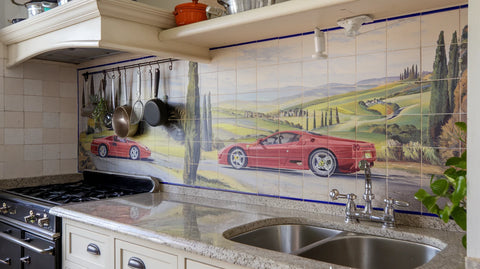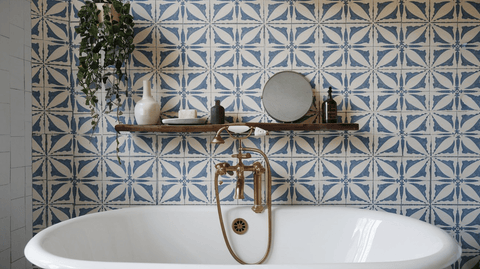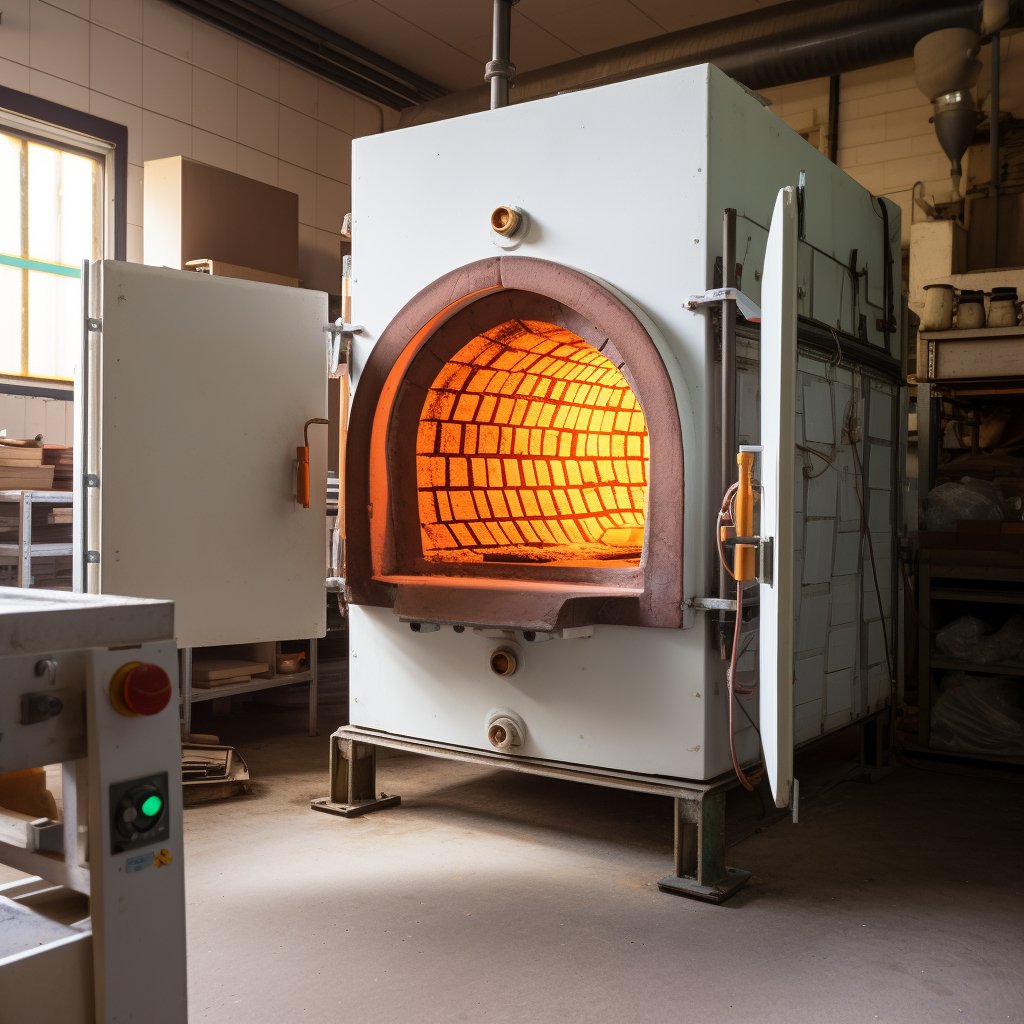Dye Sublimation VS Kiln Fired Tile Murals: Which Technique Offers Long-lasting Beauty And Durability?
Embarking on the journey of creating custom tile murals and backsplashes is akin to painting a canvas that transforms your living or working space into a masterpiece. The artistry involved in these projects not only demands a creative eye but also requires a meticulous selection of the tile-making technique to ensure the outcome is both aesthetically pleasing and enduring. The substance of beauty in tile murals is not merely in the initial allure; it is in their ability to withstand the test of time and elements, maintaining their splendor for years to come.
In the intricate world of tile murals, two primary techniques stand out as the cornerstones for transferring images onto tiles: dye sublimation and kiln firing. Each method carries its unique set of attributes and limitations, which can significantly influence the longevity and resilience of the finished product. As such, making an educated choice between these techniques is paramount for anyone aspiring to integrate a tile mural or backsplash into their decor.
This article will serve as a compass to navigate the technical landscapes of dye sublimation and kiln fired tile creation. By comparing these methods, we will dissect their processes, weigh their advantages and disadvantages, and ultimately guide you in selecting the appropriate technique that promises long-lasting beauty and durability for your tile mural or backsplash project.
Whether you are considering a serene kitchen backsplash that tells a story, a shower surround that echoes the tranquility of nature, or an outdoor mural that stands gallant against the elements, understanding the fundamental differences between dye sublimation and kiln fired tiles is the key to achieving a result that does not just captivate but also endures.
Understanding Tile Murals and Backsplashes
Tile murals are essentially large-scale, picturesque artworks ingeniously composed of smaller ceramic, stone, glass, or metal tiles. These tiles can be either glazed or unglazed, with glazed ceramic tile being a predominant choice due to its broad spectrum of color possibilities and durability. The artistry of tile murals lies in the arrangement of these tiles to create an interlocking pattern or a cohesive, larger image that can dramatically alter the ambiance of a space. This concept extends to backsplashes, which are protective panels behind sinks or stovetops, that have evolved into a canvas for interior design statements.
There is a burgeoning movement within the realm of interior design that embraces custom tile art for its versatility and aesthetic appeal. The ability to tailor tile murals to fit specific design themes or personal tastes has made them a favored element in residential and commercial spaces alike. This customization is made possible through techniques like digital printing and laser cutting, which afford precision and the replication of intricate designs on tile surfaces.
One cannot overstate the advantages of integrating tile murals and backsplashes into various spaces. In areas like pools and bathrooms, tile murals not only serve an ornamental purpose but also offer a practical solution due to their water-resistant properties and ease of cleaning. Walls adorned with tile murals can become the focal point of a room, whether it's a vibrant abstract piece in a living room or a tranquil landscape in a bedroom.
-
Durability: Tiles are known for their hard-wearing nature, making murals and backsplashes particularly long-lasting.
-
Hygiene: Given their ease of maintenance, tile surfaces can be kept hygienic with simple cleaning methods, which is vital in spaces like kitchens and bathrooms.
-
Customization: The capacity for personalization allows homeowners and designers to create spaces that truly reflect their style and vision.
-
Visual Impact: Tile murals can be stunning visual elements that transform a plain wall into a statement piece.
Whether it's the whimsical charm of comical themes or the serene beauty of tuscan landscapes, tile murals and backsplashes offer an artistic avenue to elevate the design of any space. The trend towards utilizing these elements in interior design is not only a nod to their functional benefits but also an acknowledgment of their potential to infuse life and character into our living environments.
The Process: Dye Sublimation vs Kiln Fired Technique
When it comes to creating tile murals that capture the essence of artistic expression, the techniques of dye sublimation and kiln firing stand out for their unique processes and results. Understanding these methods is crucial for anyone looking to choose the right type of tile mural for their space.
Dye sublimation is a digital printing technology that uses heat-sensitive inks. These inks turn into gas when heated and then combine with a polymer base, such as a tile's surface, resulting in a full-color, photographic-quality image that is both vibrant and durable. The process typically involves the following steps:
-
A special dye-sublimation printer is used to print the desired image onto transfer paper with sublimation inks.
-
The printed transfer paper is then placed on the tile surface.
-
Using a heat press, the tile and transfer paper are subjected to high temperatures, typically around 400 degrees Fahrenheit, which causes the inks to sublimate and permeate the tile's surface.
-
After cooling, the transfer paper is removed, leaving behind a permanent, high-resolution image on the tile.
On the other side of the spectrum, the kiln fired technique is a more traditional method that involves hand-painting or screen-printing an image onto the tile with ceramic glazes or mineral-based paints. Here's how it unfolds:
-
The design is applied to the tile using hand-painting, screen-printing, or another method.
-
The tile is then placed into a kiln where it is fired at temperatures that can exceed 1,000 degrees Fahrenheit.
-
The high heat causes the glazes or paints to fuse with the tile's surface, creating a very durable image.
The differences between these two techniques are significant, especially in terms of the materials and equipment used. Dye sublimation requires a digital printer, transfer paper, sublimation inks, and a heat press. It offers the advantage of being able to reproduce complex images with a wide range of colors. However, it's important to note that dye-sublimated tiles are not suitable for outdoor use or areas with direct UV exposure as the colors may fade over time.
Conversely, kiln fired tiles are created with mineral-based paints or glazes and require a kiln for firing. This method is known for its durability and the depth of color it can achieve, making it suitable for both indoor and outdoor use. The colors of kiln fired tiles will not fade even when exposed to sunlight, ensuring the longevity of the mural's beauty.
Many renowned artists have chosen these techniques for creating custom tile murals. For instance, using the dye sublimation process, artists like Circa Art Tile have crafted stunning murals such as the '1927 - 2 Dark Blue Chinoiserie Tile Mural' and '1916 Blue Fish Tile Mural', which display intricate patterns and vibrant hues. Kiln fired murals, such as the '1819 - Ancient Garden Tile Mural' and '1934 - VI Red Bird and Floral Chinoiserie tile', showcase the rich textures and durability that are characteristic of this time-honored technique.
In essence, the choice between dye sublimation and kiln fired techniques boils down to the desired aesthetic, the application environment, and the level of durability required. Both processes offer unique benefits, and understanding these can guide consumers to a tile mural that not only adds visual interest but also stands the test of time.
Durability: Withstanding Heat and UV Rays
When embarking on a project that involves tile murals or backsplashes, it's crucial to consider how the materials will respond to environmental factors such as heat and UV rays. These elements can be particularly punishing, leading to faded colors and compromised material integrity over time. Understanding the resilience of kiln fired tiles and dye sublimation tiles to these conditions is essential for making an informed decision for your design needs.
Kiln fired tiles are celebrated for their robustness, especially in facing the relentless onslaught of heat and UV rays. The secret to their durability lies in their very creation. During the kiln firing process, the tiles are subjected to extremely high temperatures, often in excess of 1200 degrees Celsius. This not only solidifies the tile but also vitrifies the glaze, effectively sealing the colors and patterns within a glassy, protective layer. This process ensures that kiln fired tiles maintain their vibrant appearance even when subjected to UV rays, making them an ideal choice for outdoor spaces such as pool areas, outdoor kitchens, and public parks, where direct sunlight is a daily occurrence.
In contrast, dye sublimation tiles are known to have certain limitations when it comes to handling heat and UV exposure. The dye sublimation technique involves transferring images to tiles at a much lower temperature and, while it produces beautiful results for indoor use, these tiles lack the heat-forged armor of their kiln fired counterparts. The dyes in these tiles can begin to fade when exposed to direct sunlight over time, limiting their use to areas that are not subjected to the harsh rays of the sun.
For those considering tile murals in environments where the sun's embrace is as persistent as a love-struck Romeo, kiln fired tiles are the go-to option. They are not only impervious to UV rays but also to the freeze/thaw cycles that can wreak havoc on less sturdy materials. This makes them a perfect match for outdoor installations in regions with volatile climates, offering both beauty and peace of mind. As highlighted in benefits of outdoor porcelain, the innate properties of kiln fired porcelain tiles render them virtually immune to the elements, ensuring that the tile's appearance remains as steadfast as its functionality.
Ultimately, the selection between dye sublimation and kiln fired tiles boils down to their intended application. While dye sublimation tiles can be a cost-effective and swift solution for indoor settings, the superior endurance of kiln fired tiles against heat and UV rays makes them an undeniable champion for outdoor use. By choosing the appropriate tile type, you can ensure that your mural or backsplash remains an enduring testament to your aesthetic vision, unmarred by the trials of Mother Nature.
Maintenance and Care
Maintaining the allure and longevity of tile murals and backsplashes is paramount, whether you choose the vibrant aesthetics of dye sublimation tiles or the enduring charm of kiln fired tiles. Kiln fired tiles benefit from their resilience in high traffic areas, standing up to the rigors of daily life with ease. A regimen of cleaning and periodic sealing ensures their continuous luster and protection from stains.
Conversely, dye sublimation tiles, while rich in color and detail, call for a gentler touch. They necessitate vigilance against scratches and chips to preserve their intricate designs. The maintenance of these tiles often involves using soft cloths and avoiding abrasive cleaners to keep the surface unblemished.
When comparing the two, kiln fired tiles offer a robust option that merges durability with ease of maintenance, a combination that is particularly beneficial in bustling environments where practicality is as appreciated as visual appeal.
Personalization and Design
When it comes to personalizing your space with tile murals, the techniques used can make a significant difference in the outcome. Dye sublimation tiles offer a degree of personalization with the ability to transfer digital images onto tiles, suitable for indoor applications like kitchen backsplashes. However, this method has its drawbacks as it limits color vibrancy and design complexity due to its susceptibility to fading, particularly with exposure to sunlight, making it less ideal for areas that receive natural light.
On the other hand, kiln fired tiles boast a robust personalization palette. Not only can they replicate famous artworks, but they also allow for a rich spectrum of colors and textures. This process melds the design into the tile itself, providing a durable and fade-resistant finish. This makes kiln fired tiles a superior choice for both indoor and outdoor installations, where longevity and aesthetic versatility are paramount. The current design trend leans towards using custom tile murals and backsplashes as statement pieces in interior design, and kiln fired tiles rise to the occasion with their unlimited design capabilities.
Installation and Project Considerations
When it comes to installing tile murals, both dye sublimation and kiln fired tiles offer unique challenges and benefits. Dye sublimation tiles may require a more delicate touch due to their susceptibility to fading in direct sunlight. Consequently, the installation process is often conducted indoors with careful consideration to avoid exposure to UV rays. On the other hand, kiln fired tiles boast ease of installation owing to their enhanced durability, making them suitable for both indoor and outdoor environments.
For a flawless finish, kiln fired tiles can be laid out with the assistance of wall tile spacers, ensuring even gaps and straight lines. Additionally, when dealing with mosaic floor tiles, these spacers are indispensable for maintaining a smooth surface, crucial in areas like pool surrounds or patios.
-
Are wall tile spacers necessary for dye sublimation tiles?
-
While not mandatory, spacers can aid in achieving a uniform look.
-
-
Can dye sublimation tiles be used outdoors?
-
It's not recommended due to potential UV damage.
-
-
What makes kiln fired tiles easier to install?
-
Their robustness permits handling without the risk of fading.
-
Ultimately, the choice between dye sublimation and kiln fired tiles hinges on the mural's location and the desired longevity of the artwork.
Conclusion
As we draw our discussion to a close, it's essential to weave together the threads of information regarding dye sublimation and kiln fired tile techniques. Each method, with its unique approach to transforming clay into art, comes with its set of advantages and challenges that could sway your decision when choosing the perfect tile mural or backsplash for your space.
Dye sublimation is akin to a chameleon, versatile for indoor use with its capability to transfer intricate designs and vibrant images onto tiles. Its cost-effectiveness is its shining armor, making it an attractive option for budget-conscious decorators. However, this method has its Achilles' heel: the tiles' susceptibility to the sun's kiss, leading to a faded beauty over time, and their less-than-stellar weather resistance. Thus, dye sublimation is best kept within the cozy confines of your interior spaces, away from the harsh scrutiny of sunlight and external elements.
On the flip side, kiln fired tiles are the stalwarts of tile craftsmanship. Forged in the fiery belly of a kiln, these tiles emerge with a resilience that can weather the storms of external environments and the relentless march of time. Their resistance to the sun's ultraviolet serenade means that their colors remain as vivid as the day they were fired. This durability, coupled with their design versatility and ease of maintenance, makes kiln fired tiles the preferred choice for those seeking a long-lasting investment in beauty.
The artistry involved in kiln fired tiles cannot be overstated. With the use of specialist ceramic printers and toners, these tiles can be adorned with bespoke designs that capture the essence of your vision. Although this process is more labor-intensive and pricier than dye sublimation, the ability to withstand the elements and the passage of time is a testament to their value. Whether gracing the grounds of a garden, the edge of a pool, or the facade of a commercial establishment, these tiles stand as a beacon of enduring elegance.
In conclusion, when contemplating the creation of custom tile murals or backsplashes, the decision should not be taken lightly. The longevity, beauty, and durability of your project hinge on the choice of technique. While dye sublimation offers a cost-friendly solution for interior designs, kiln fired tiles ascend as the paragon of tile artistry, capable of withstanding the tests of time and nature. Let this knowledge guide you in selecting the right technique to ensure that your custom tile art remains a source of pride and joy for generations to come.






